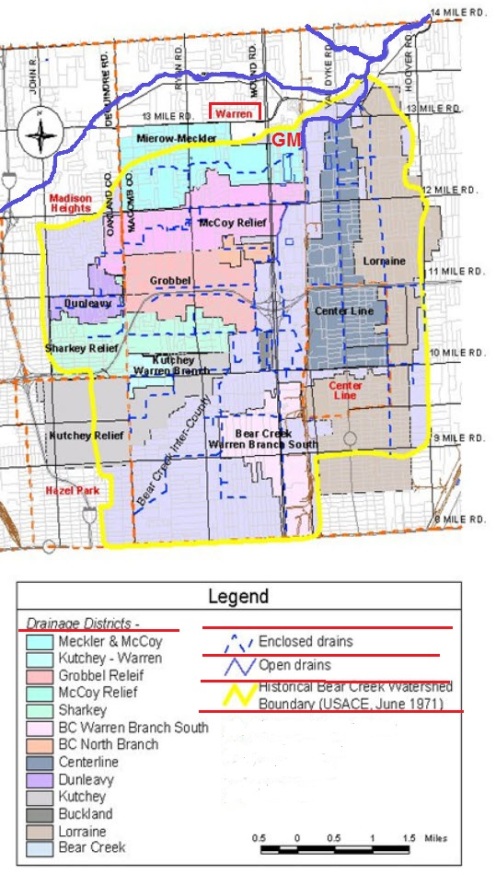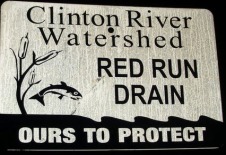Ten Mile Drain Site 2014
Neighborhoods are inter-connected via underground drain pipes.
Everything drains into the Detroit River and Lake St. Clair.
It also happens to be where many of us get our drinking water.
A several block area where polychlorinated biphenyls (PCBs)
has been documented to be present in significant quantities
exists in an underground storm sewer drain system.
The 10 Mile storm sewer system is approximately 15 feet
underground and empties into two residential canal systems
connected to Lake St. Clair.
The area of concern for this site includes sewer lines
in and around the intersection of Bon Brae Street
and Harper Avenue in St Clair Shores, Mich.
http://binged.it/1sEJkcZ
Over the past nine years, Michigan Department of Natural Resources
and the Environment (DNRE), Macomb County Public Works Office
(MCPWO), City of St. Clair Shores, Macomb County Health Department,
and U.S. EPA’s Removal Response staff have done extensive cleanup.
They have responded to residents’ concerns and conducted
investigations at the site,
but a source has not been found
– consequently the drains and canals have been re-contaminated.
http://www.detroitnews.com/article/20090401/METRO/904010365
U.S. EPA’s work at the Ten-Mile Drain Site has moved from the
removal branch to the remedial branch of EPA Superfund.
Agency remedial staff work on long-term cleanup projects.
The emphasis will be on finding the source(s) of PCB contamination
found in the underground storm sewer drain system.
Once the source(s) have been identified, the next step will
be to conduct a comprehensive investigation to determine
the nature and extent of the PCB contamination and evaluate
any potential risks to human health and the environment.
~~~~~~~~~~~ click to enlarge images ~~~~~~~~~~~~~~
Entire Webpage available here
http://www.epa.gov/region05/cleanup/tenmiledrain/index.html
PCBs are a class of synthetic, chlorinated organic chemicals
produced mainly for their excellent insulating capabilities
and chemical stability. They were produced in the form of
complex mixtures for industrial use in the United States
from 1929 to 1977, mostly by the Company, Monsanto,
which produced approximately 640,000 tons.
Peak production occurred in 1970, and over half of total
United States production occurred between 1960 and 1974
(de Voogt and Brinkman, 1989).
Production is difficult to estimate because there were
209 congeners, 9 homologs, many technical mixtures,
and many different trade names used throughout the
production period (e.g., Aroclor, Askarel, Inerteen).
PCBs were used in the United States for a number of applications,
but primarily consisted of closed system and heat transfer fluids
-transformers, capacitors, fluorescent light ballasts
– plasticizers – hydraulic fluids and lubricants, other.
A major use in Michigan for PCBs was in the production
of recycled carbonless copy paper.
The National Cash Register Company purchased a specific
mixture of PCBs (Aroclor 1242) from Monsanto to be used
as an ink carrier or solvent between 1957 and 1971.
The solvent was also licensed for use to several other
paper manufacturers in the Great Lakes region.
The total use of PCBs for this purpose was about
28 percent of total plasticizer use and just over
6 percent of total Monsanto sales.
The USEPA banned production of PCBs in 1979 due to their
toxic properties, and this class of chemicals was
ultimately phased out of new uses in 1983.
PCBs have been shown to cause a variety of adverse
health effects, notably cancer in animals.
Non-cancer effects include impacts to the nervous, immune,
reproductive, and endocrine systems, among other adverse effects.
PCBs are relatively persistent (i.e., do not readily degrade)
and hydrophobic; consequently the higher chlorinated congeners
tend to accumulate in suspended and bottom sediments
of aquatic systems. Also, PCBs hydrophobicity means they
generally have low water solubility and high solubility in
most organic solvents, oils, and fats.
Therefore, PCBs concentrate in the fatty tissues of organisms
and bioaccumulate in living tissues.
Thus, despite the United States ban of PCB production,
PCBs remain in the environment in soil, water, air,
animal tissue, and vegetation.
Because the industrial use of PCBs has been banned, the
primary sources of PCBs to water likely are
historical sediment contamination.
Learn more about PCBS
http://www.michigan.gov/documents/deq/wrd-swas-tmdl-draftpcb_408124_7.pdf




